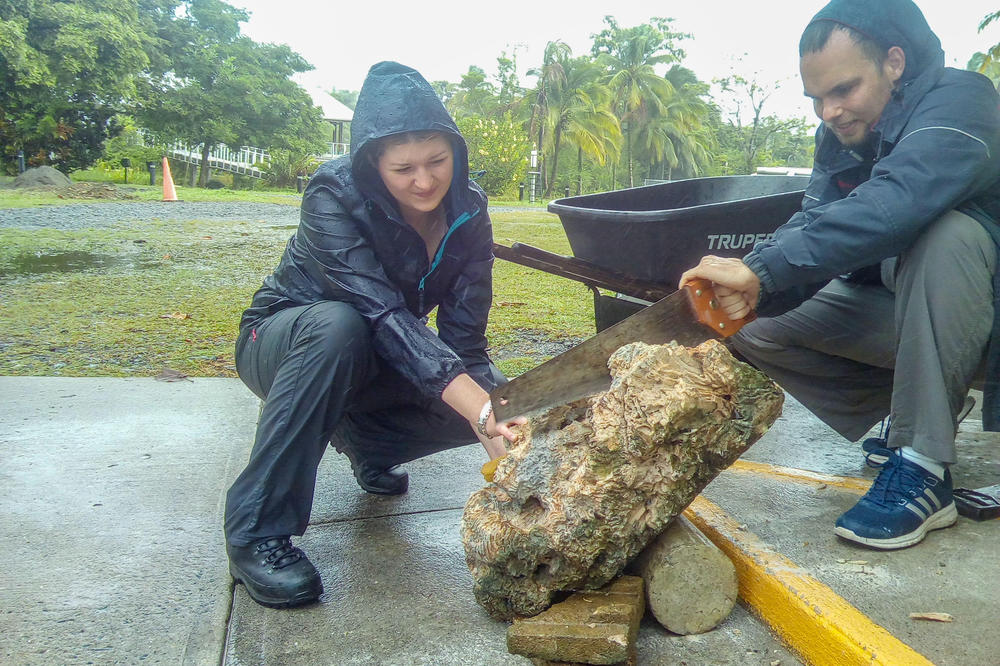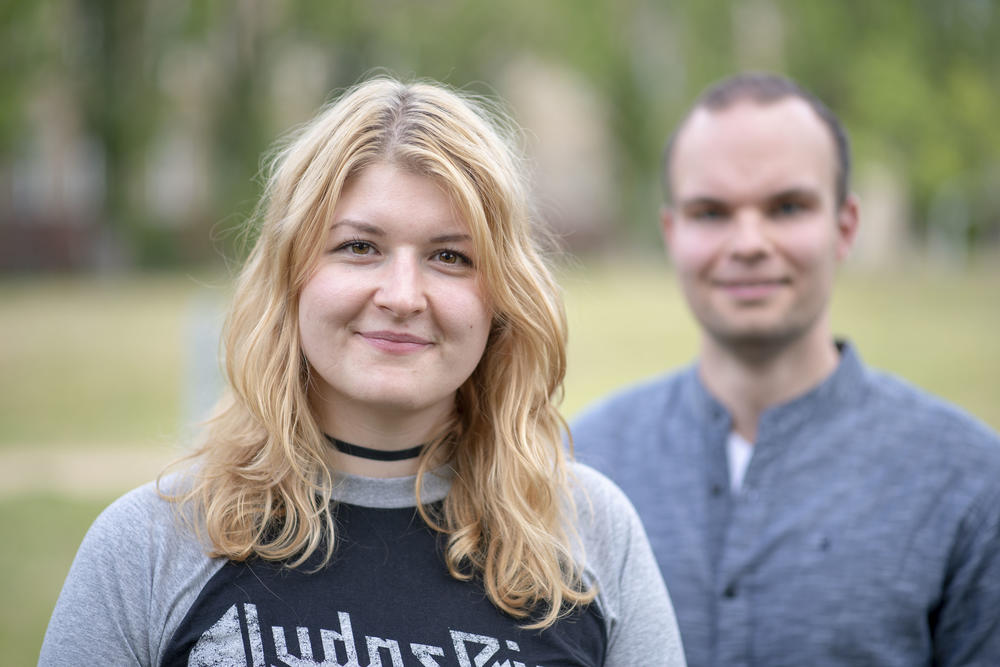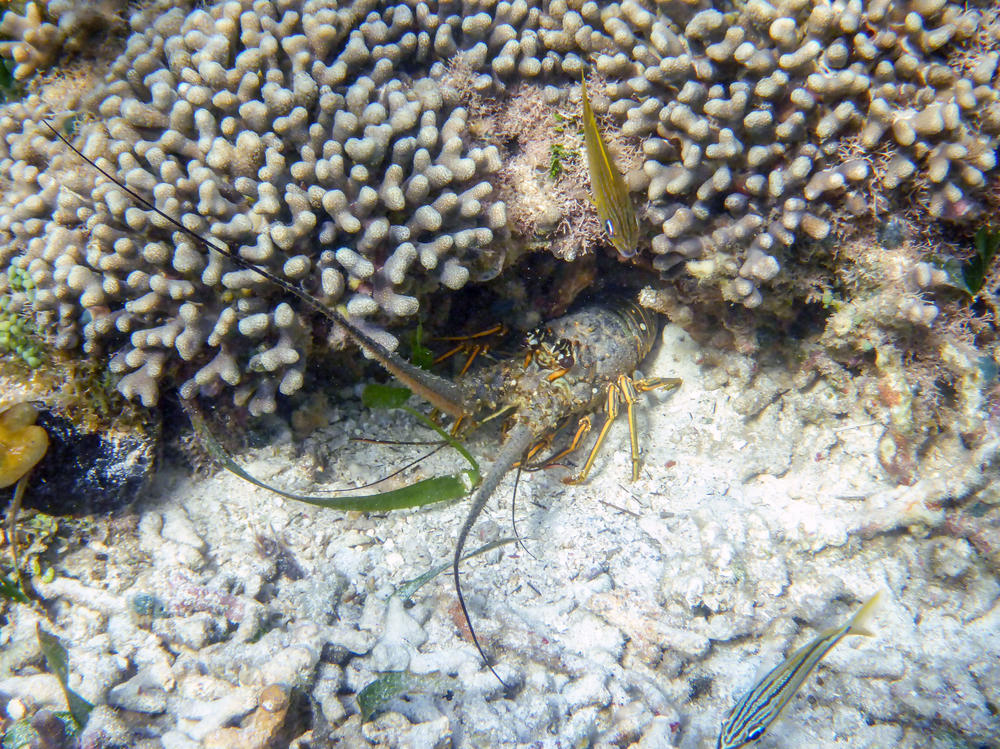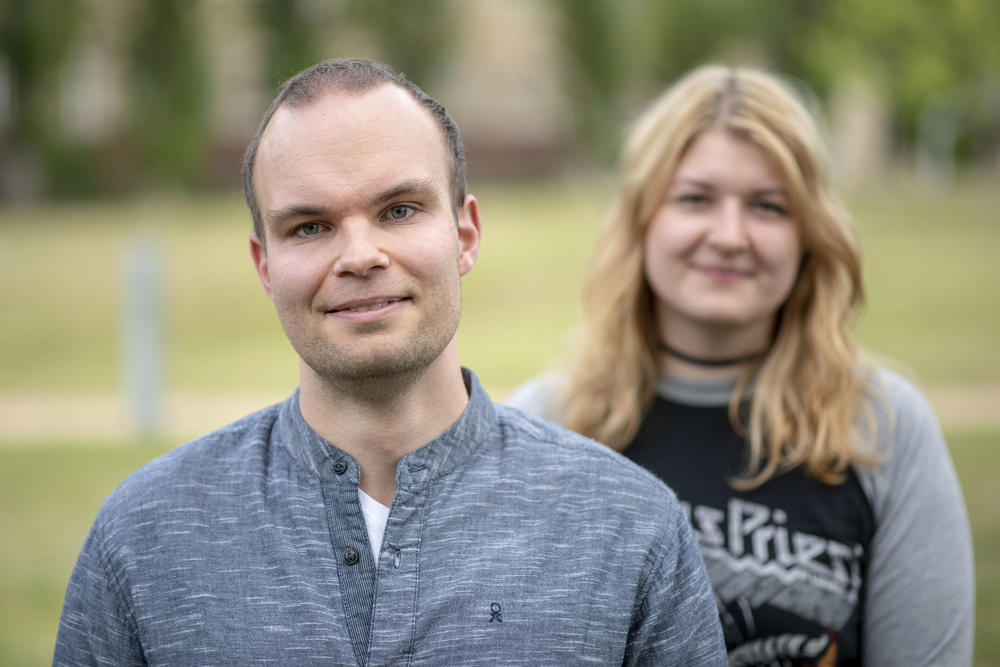“Corals are unique creatures”
It sounds like an adventure holiday in the Caribbean: Geology student Vanessa Skiba (24) and biology student Oliver Voigt (27) did research off the coast of Panama for two months – with a snorkel, a canoe, a saw, and support from the ERG.
Oct 23, 2019
Vanessa Skiba and Oliver Voigt had to saw up coral pieces weighing up to 15 kilograms.
Image Credit: private collection
“Corals are unique creatures and are important for humans and nature in many ways,” says Oliver Voigt. “They take on a variety of ecological functions, such as habitat and breeding grounds for fish, or as breakwater and erosion protection for the coast.” In the future, they could even be useful for the production of medicines.
“Unfortunately, coral reefs in the oceans have been dying, and this is on the increase,” says Vanessa Skiba. For more than two decades, scientists have been observing that stony corals worldwide are losing their color over a large area, so-called coral bleaching. This is due to the warming of the oceans as the result of anthropogenic climate change. Corals live in symbiosis with Zooxanthellae, which are tiny, photosynthetic organisms. They provide the corals with important nutrients, but are highly sensitive to heat. If they are too hot, they produce toxins and the corals repel them. The corals not only lose their color, but also their vital nutrient suppliers. When no new zooxanthellae are found, the corals die.
As part of her master’s thesis, Vanessa Skiba will analyze the corals from Panama in the laboratory and investigate these findings with regard to climate change.
Image Credit: Bernd Wannenmacher
Vanessa Skiba and Oliver Voigt are particularly interested in the coral species Siderastrea siderea, which lives in the Almirante Bay in northern Panama. “There, too, many changes have led to massive coral bleaching in recent decades,” says Vanessa Skiba.
In November and December last year, they were able to live and work for several weeks in a research station in the bay, which is run by the prestigious Smithsonian Institution. The situation in the Caribbean is particularly precarious for corals.
Climate Change Is Warming the Water
“In the Caribbean the water is getting hotter faster due to climate change than in any other region,” says Voigt. “This is compounded by overfishing and massive numbers of tourists and extreme weather events such as El Niño.” An additional problem stems from the relentless exploitation of natural resources. Due to massive clearing by the plantation industry, sediments are deposited on the reefs. “In the countryside there are hardly any trees left whose roots hold the soil together,” says Voigt. “As a result of wind and rain, landmasses are increasingly ending up in the sea.” As the sediment clouds the water, it gets darker for the corals, and the photosynthesis process is disturbed.
Coral reefs like those in the Panamanian Almirante Bay are a diverse habitat. They protect the coast from erosion and serve as a breakwater.
Image Credit: private collection
Their most important tools in Panama included canoes, snorkels, and saws. The samples they collected weighed up to 15 kilos, which Skiba and Voigt then transported to the research station, where they cleaned them and sawed them up. “That was back-breaking work,” says Vanessa Skiba. “We only had a handsaw available, and many days consisted only of sawing, sawing, sawing.”
Oliver Voigt pointed out that he and Vanessa Skiba were welcomed very warmly at the research station. “We enjoyed every day and learned a lot,” said Vanessa Skiba. Back in Germany, they started a closer inspection of the corals.
For his bachelor’s thesis Oliver Voigt investigated how Siderastrea siderea grows in Almirante Bay and how it behaves in relation to current climate changes. He had some relatively good findings to report: This coral species seems to be more resilient than other local species.
As a budding biologist, Oliver Voigt found out that the coral species “Siderastrea siderea” seems to be more resistant than other coral species in Panama.
Image Credit: Bernd Wannenmacher
Geologist Vanessa Skiba is more interested in the past. She is writing her master’s thesis in the field of paleoclimatology. “Corals can live for several hundred years and serve as a climate archive,” she says. “Similar to the growth rings of the trees, their structure provides insights into past environmental conditions.”
Therefore, in Panama she collected mainly fossil corals, which she will now evaluate in the lab for her master’s thesis. Skiba hopes to use the corals to gain information about the climate conditions in the Middle Holocene, about 7,000 years ago. She is particularly interested in the seasonal pattern of climatic parameters, which may have been different at the time due to differences in the Earth’s orbit from today.
Coral Samples Being Stored on Geo Campus in Lankwitz
The roughly 20 samples taken during their research stay are not only useful for the research projects of Skiba and Voigt. “The samples will be stored on the Geo Campus in Lankwitz,” says Skiba, who joined the Ernst Reuter Society after her return from Panama. She continues, “We are very pleased that the samples will continue to be available in the future for other students to use in their research.”
The original German version was published on June 12, 2019, in the alumni magazine wir, which is published by the Ernst Reuter Society.




